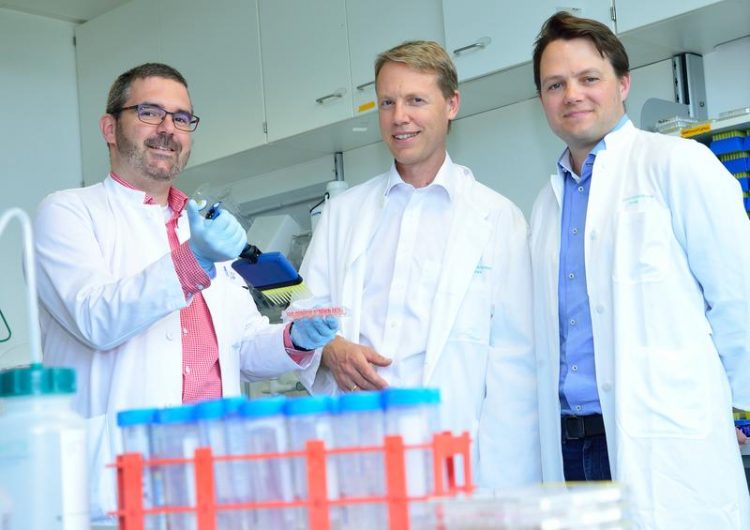Natural killer cells have a memory

Dr. Jasper van den Boorn, Prof. Dr. Gunther Hartmann and Prof. Dr. Veit Hornung in the lab of the Institute of Clinical Chemistry and Clinical Pharmacology at the University Hospital Bonn. © Photo: Rolf Müller/Ukom UKB
Pigmented cells of the skin are crucial as a protective shield against UV-radiation. An often-desired suntan can only form with the aid of the enzyme tyrosinase inside these pigmented cells. The more exposure to sunshine, the more pigments are formed by this enzyme.
The compound monobenzone can specifically block tyrosinase and thereby trigger a stress reaction. As a result, the immune system attacks the affected pigmented cells. A frequent consequence is vitiligo, which leads to milky-white unpigmented areas on the skin.
Scientific studies have shown that people with vitiligo are at lower risk of developing malignant melanoma. A possible method for treating this type of cancer could involve actively triggering vitiligo with the tyrosinase blocker monobenzone.
“The idea is to use a less severe disease as a weapon against malignant melanoma,” says Dr. Jasper van den Boorn from the Institute of Clinical Chemistry and Clinical Pharmacology of the University of Bonn, who previously researched this connection in his doctoral thesis at the University of Amsterdam and demonstrated the fundamental feasibility of this option.
Contact allergen must first be “activated”
“However, the initial mechanism by which the immune system identifies the monobenzone-exposed pigmented cells as dangerous, before attacking them, has been unclear so far,” reports Prof. Dr. Veit Hornung, who recently moved from the University of Bonn to the Ludwig-Maximilians-Universität in Munich.
It is known that monobenzone has a contact-sensitizing effect on pigmented skin: In principle, this substance alone is inactive. Only when monobenzone docks onto the tyrosinase enzyme, a so-called hapten is generated in the pigmented cell. This is a newly formed “foreign structure” that can specifically activate the immune system. By applying low doses of monobenzone several times in succession on the rodents' skin the researchers explored this path in detail on mice.
The way in which the animals' immune defense reacted to this hapten amazed the researchers. “Normally the immune system mobilizes a mixture of various white blood cells to attack hapten-exposed tissues,” reports Dr. van den Boorn. “However, the multiple monobenzone exposures induced only natural killer cells to recognize and attack the pigmented cells.” Natural killer cells are part of the innate immune system and kill abnormal cells – such as cancer cells or virus-infected cells. Previously, scientists believed that they did not have the capacity to remember and specifically attack the body's own tissues. Up to now, this phenomenon has only been attributed to T and B lymphocytes.
“However, our results clearly show that natural killer cells can also carry out a long-lasting and effective immune reaction against the body's own pigmented cells, including malignant melanoma cells,” says Prof. Dr. Gunther Hartmann, Director of the Institute of Clinical Chemistry and Clinical Pharmacology of the University of Bonn. The researchers established this by studying mice that were not able to form any functional T and B lymphocytes. Nonetheless, white spots still developed in the animals' fur, and previously transferred malignant melanoma cells were destroyed, because the mice’s natural killer cells remembered and attacked the pigmented cells.
The NLRP3 inflammasome serves as a checkpoint
In order for this immune response to occur, an immune-checkpoint had to give the green light first: the NLRP3 inflammasome. “This is a protein complex that integrates multiple pieces of signaling information in macrophages, special phagocytes that reside in tissues. Once switched on, macrophages then decide whether immune cells including natural killer cells receive their marching orders,” explains Prof. Dr. Veit Hornung. If the researchers incapacitated this checkpoint, the monobenzone-induced tyrosinase hapten did not trigger the desired immune reaction anymore.
The results may open up new therapeutic avenues for the treatment of malignant melanoma, demonstrate a new type of immune recognition and could even shed new light onto the incipient events causing the development of vitiligo.
Publication: Jasper G. van den Boorn, Christopher Jakobs, Christian Hagen, Marcel Renn, Rosalie M. Luiten, Cornelis J.M. Melief, Thomas Tüting, Natalio Garbi, Gunther Hartmann & Veit Hornung: Inflammasome-dependent induction of adaptive NK cell memory, Immunity, DOI: 10.1016/j.immuni.2016.05.008
Media contact information:
Dr. Jasper van den Boorn
Institute of Clinical Chemistry and Clinical Pharmacology
University of Bonn Hospital
Tel. ++49-228-28751143
E-Mail: jvdboorn@uni-bonn.de
Prof. Dr. Veit Hornung
Gene Center and Department of Biochemistry
Ludwig Maximilian University of Munich
Tel. ++49-89-2180711110
Email: hornung@genzentrum.lmu.de
Media Contact
More Information:
http://www.uni-bonn.de/All latest news from the category: Health and Medicine
This subject area encompasses research and studies in the field of human medicine.
Among the wide-ranging list of topics covered here are anesthesiology, anatomy, surgery, human genetics, hygiene and environmental medicine, internal medicine, neurology, pharmacology, physiology, urology and dental medicine.
Newest articles

Silicon Carbide Innovation Alliance to drive industrial-scale semiconductor work
Known for its ability to withstand extreme environments and high voltages, silicon carbide (SiC) is a semiconducting material made up of silicon and carbon atoms arranged into crystals that is…

New SPECT/CT technique shows impressive biomarker identification
…offers increased access for prostate cancer patients. A novel SPECT/CT acquisition method can accurately detect radiopharmaceutical biodistribution in a convenient manner for prostate cancer patients, opening the door for more…

How 3D printers can give robots a soft touch
Soft skin coverings and touch sensors have emerged as a promising feature for robots that are both safer and more intuitive for human interaction, but they are expensive and difficult…





















